Reference Book
Do what you can to reduce personal risk
~and an earthquake will not be so threatening~

No2 --Do Not Panic within your Surroundings
No3 --Secure Your Furniture
No4 --Be Prepared with Emergency Rations
No5 --Prepare for Secondary Earthquake Disaster
No6 --Making an Emergency Contact Plan for Your Family
No7 --Be prepared for life in an evacuation centre
No8 --Master First Aid
No9 --Earthquake help sheet (Keep for your records)
Publication:Shiga Prefecture 発行:滋賀県
Translation/Edition:Shiga Intercultural Association for Globalization 「Mimitaro」
翻訳編集:滋賀県国際協会・ボランティアグループ「みみタロウ」
Download PDF
When you hear BANG! When you hear CRASH! Don't Panic!
There have been several large earthquakes in Japan recently. The fault west of Lake Biwa, and nearby Tonankai and Nankai areas are seen to threaten a large earthquake and damage over a wide area of Shiga. This is the first in a series to help you be fully prepared in case an earthquake happens. |
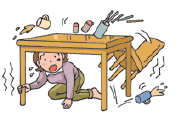 *Give priority to protecting yourself. Get under a table,
bed or like object. If you were sleeping use the pillow to
protect your head. *Give priority to protecting yourself. Get under a table,
bed or like object. If you were sleeping use the pillow to
protect your head.
*Get in to the habit of turning off the gas, even if it is just a small shake. However do not put yourself at unnecessary risk because the gas mains have a safety breaker. |
|
 |
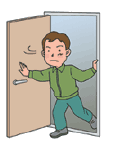 *Secure emergency exits. Secure escape routes by opening
doors and windows. Doors at apartment blocks might be difficult
to open but windows are comparatively easy. *Secure emergency exits. Secure escape routes by opening
doors and windows. Doors at apartment blocks might be difficult
to open but windows are comparatively easy.
*Find the source of any fire and extinguish it straight away. *Wear shoes, even inside. This protects your feet from debris like broken glass and allows immediate escape. *Check that your family is safe. Leave the house if it is likely to collapse or suffer from a landslide. When outside be aware of falling roof tiles, window glass, signboards, etc |
|
 |
*Prepare portable emergency kit.
*Check for fires in the neighbourhood. *Gather information. Get information from verified sources like the radio. Do not be misled by rumour. |
|
 |
 *Check up on the safety of people who need help in your
community. *Check up on the safety of people who need help in your
community. |
|
 |
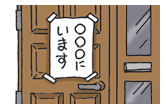 *Evacuate if there is a danger of building collapse, fire, etc resulting from
aftershocks. *Evacuate if there is a danger of building collapse, fire, etc resulting from
aftershocks.
*Collect your children from school. *Prevent fire. Close main gas cock. Shut the electricity breaker when leaving the house. *Leave a note of your whereabouts visible at the entrance of your house when you go out. |
|
|
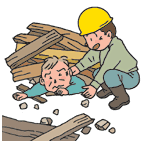 *Use your emergency supplies. It is important to fend for
yourself but help others in need too. *Use your emergency supplies. It is important to fend for
yourself but help others in need too.
*Help with rescues and fire prevention in your area. Inform the fire department and other authorities if necessary. *Evacuate in a group. Evacuate on foot avoiding concrete block walls and broken electric cables etc.  *Get information. Pay
attention to municipal news bulletins. *Get information. Pay
attention to municipal news bulletins. |
Do Not Panic within your Surroundings
Street of Buildings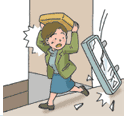 Watch out for collapsing
buildings, falling objects such as
broken window glass or signs,
and the falling vending machines.
Protect your head with a
handbag and evacuate to an
open space. Watch out for collapsing
buildings, falling objects such as
broken window glass or signs,
and the falling vending machines.
Protect your head with a
handbag and evacuate to an
open space. |
Residential area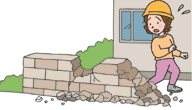 Watch out for falling
walls, gateposts, glass,
roof tiles, and electrical
wires. Watch out for falling
walls, gateposts, glass,
roof tiles, and electrical
wires.
|
Underground shopping area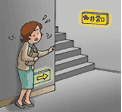 The structure is durable and well
equipped for fire. Follow
instruction signs and guides to
evacuate calmly after an
earthquake has stopped. The structure is durable and well
equipped for fire. Follow
instruction signs and guides to
evacuate calmly after an
earthquake has stopped.
|
When driving a car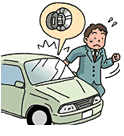 Hold the steering wheel firmly,
pull over to the left side of the
road and gather information
from the radio. When you
evacuate from the car, close the
window, keep the door unlocked,
leave the key in the car, and take
your car registration if possible. Hold the steering wheel firmly,
pull over to the left side of the
road and gather information
from the radio. When you
evacuate from the car, close the
window, keep the door unlocked,
leave the key in the car, and take
your car registration if possible.
|
Elevator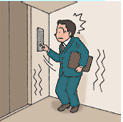 Push buttons for all floors and
get out on the floor where the
elevator first stops. If you are
trapped, continue pushing the
emergency button. Push buttons for all floors and
get out on the floor where the
elevator first stops. If you are
trapped, continue pushing the
emergency button. |
Department store/SupermarketCover your head with a shopping basket or handbag. Wait at a safe place until earthquake stops so not to be crushed under articles or a shelf. Follow the instructions by the store staff for evacuation. |
Train/Subway/Bus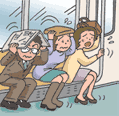 Hold on to the front seat or
handle with both hands tightly.
When you escape from the
emergency exit, follow the
instructions of the staff. Hold on to the front seat or
handle with both hands tightly.
When you escape from the
emergency exit, follow the
instructions of the staff. |
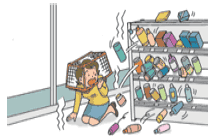 |
Care for people who need assistance in times of disaster
*People who need assistance in times of disaster:People who have hard time coping with disaster by themselves, such as elderly people&babies,People who have physical or mental disabilities.
*Elderly / Injured people Use an emergency stretcher or
carry them on your back to
evacuate. Use an emergency stretcher or
carry them on your back to
evacuate.
|
*People with vision disability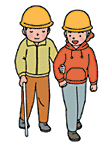 When you evacuate, have them hold
your elbow by one hand and hold
the cane with the opposite hand.
Guide them slowly. Walk carefully
while explaining location of stairs
and other obstacles. When you evacuate, have them hold
your elbow by one hand and hold
the cane with the opposite hand.
Guide them slowly. Walk carefully
while explaining location of stairs
and other obstacles.
|
*People with hearing disability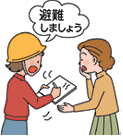 Use gestures, write
messages, or speak to them
moving your mouth widely. Use gestures, write
messages, or speak to them
moving your mouth widely. |
Secure Your Furniture
Chest* Confirm the strength of the ceiling before using the expandable bar.* Furniture on the carpet and tatami mat can fall down easier. Move it to different room or place a board underneath. * If you do not want any markings/scratches on the furniture,or screws cannot be used, add another board on the furniture surface and screw into it. 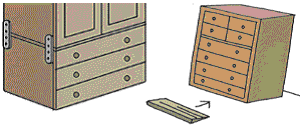 |
Buffet / Book shelf* Store heavier books towards the bottom of the shelf. Reduce gaps between books as much as possible.* Apply splash prevention film on the glass. * Placing fabric underneath dishes can prevent slippage. * Avoid placing objects on the top of the shelf (They may fall off ). 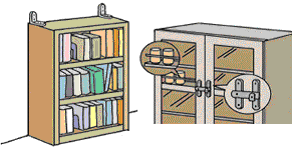 |
|||
TV / Computer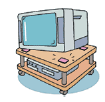 *
Do not set it in high place. *
Do not set it in high place.* Confirm the weight and expiration date of resin quake-absorbing sheet. For an extremely heavy object, use it with caution. |
Refrigerator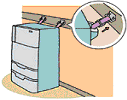 *
Use latches to secure drawers from opening. *
Use latches to secure drawers from opening.
* Secure the refrigerator to the wall using the little knob on the back side (some models take special fixture) or use the wire between doors and attach it to the wall. |
|||
Lighting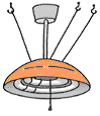 *
Secure the light bulb with the heat resistant tape. *
Secure the light bulb with the heat resistant tape.* Use wire or chain to secure hanging type lighting fixture to the ceiling (2~3 areas). |
Piano*Use slip stopper for the legs. For the body, use plastic coated or taped wire (these products will not scratch the body of the piano) to secure from the wall. |
|||
Base of the walls*When securing furniture to the wall using hook, wire, chain or L shaped clamp, make sure that the screw is attached to the post, beam, center pillar or middle rail.*Plasterboard may not secure objects strong enough. |
Air conditioning / Clock / Pictured frame*Use L shaped clamp or hook to secure to the wall. |
|||
Furniture Arrangement
|
||||
Be Prepared with Emergency Rations
Emergency Rations Check the list for more details.
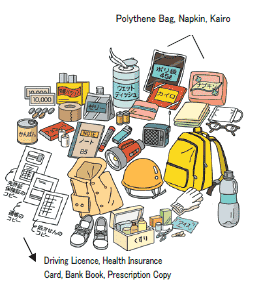 These are the supplies that you take with you when you take
refuge after an earthquake. They should be stored with gloves,
shoes, a helmet etc, under or close to your bed. 15kg for men,
10kg for women and a comfortable weight for children is a good
guide for load. Supplies should be packed into a rucksack for each
person ready to escape.
These are the supplies that you take with you when you take
refuge after an earthquake. They should be stored with gloves,
shoes, a helmet etc, under or close to your bed. 15kg for men,
10kg for women and a comfortable weight for children is a good
guide for load. Supplies should be packed into a rucksack for each
person ready to escape.* Other Useful Items: Mobile phone charger (car cigarette lighter or disposable type), powdered milk, baby feeder, disposable nappies (diapers) rash ointment, cleansers, Maternity Record Book copy, baby food, reserve medication, prescription copy, okayu rice, hearing aid, radio, etc.
* Personal name stamp (inkan), bank book, title deeds, precious metals should be stored in a bag that can be reached easily when you escape.
Emergency Supplies
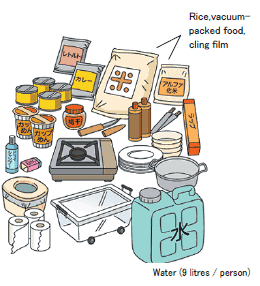 It is essential that you can survive until rescue help arrives. You
should prepare enough for three days survival. Everything should
be at hand when you need to escape.
It is essential that you can survive until rescue help arrives. You
should prepare enough for three days survival. Everything should
be at hand when you need to escape.
Buying extra of your normal daily food results in a slightly luxurious emergency supplies if you have to escape. Don't forget to keep it fresh!
Other Equipment
 You should leave tools in the place that they are needed
You should leave tools in the place that they are needed*Kitchen,Living Room (Fire Extinguisher)
*Tools to escape from building (Axe)
*Tools to escape from upper floors (Rope)
In order to get home from work on foot you should prepare the following: suitable shoes, gloves, towel, food, water, suitable clothes, map, photographs of your family, etc.
Where to Buy
Outdoor shops and home centres have emergency supplies corners but you can get what you need from almost any shop. It is a good idea to prepare emergency supplies as you do your everyday shopping .
* Food:A mixture of long-life and everyday foods is recommended. Keep it fresh!* Torch & Radio:From electrical shops. Non-battery(solar, wind-up) types available.
* Helmet: Construction site helmets can be bought at Home Centres, construction shops and DIY Shops. Cycle and motorcycle helmets can also be used.
Prepare for Secondary Earthquake Disaster
3 chances to extinguish fire
1 When you felt a quakeIf the initial quake is not too strong, put out the fire immediately. Make a habit of putting out fire even with a small quake.2 When a quake settles downIt is more dangerous to go near the fire in the middle of a strong quake. Wait until the movement settles, then put out the fire.3 When fire breaks outThe first 3 minutes after the fire breaks out is the most critical time. Even for the small fire, shout to neighbors for help and call 119. Utilize any ready material besides fire extinguisher or water, such as a wool blanket, to put out fire. However, when the fire reaches the ceiling, evacuate immediately. Close the door and windows of the room with fire to cut out the air supply. |
How to use fire extinguisher<1> Put finger through safety pin and pull upward. <2>Release hose and aim for the base of fire.  <3> Push lever hard to shoot out the agent.  <4> Move hose from side to side. <5> Face against the door to keep the passage clear from smoke and extinguisher agent. |
How to put out fire by type of origin
Pan with hot oil* Do not put water.* Cover it with wool blanket or big wet towel from the front of the pan to cut out air supply (can use extinguisher). * Do not throw in mayonnaise.  |
Kerosene heater* Dump the water from the top.* If kerosene is spreading on the floor, cover it with wool blanket, etc. then, dump the water (can use extinguisher).  |
Yourself* Roll on the floor, have someone beat out the fire (can use extinguisher).* If your hair is burning, cover your head with towel or clothing (do not use synthetic fiber). Curtain/Paper sliding doorIn order to prevent the fire from reaching the ceiling, take down the curtain and kick down the sliding door before putting out the fire. |
Bath* Remember that the fire may gain force if the door is opened without caution.* Turn off the main cock of the gas, and then gradually open the door. Put out fire all at once. |
Electronics* Unplug electronics, and then put out fire. |
Key point for evacuation from fire
 * When the fire reaches to the ceiling, do not fight it.
Evacuate immediately.
* When the fire reaches to the ceiling, do not fight it.
Evacuate immediately.* Assist people with disabilities first.
* Do not worry about what you are wearing or what to take with you. Evacuate as soon as possible.
* If running through fire, run without hesitation.
* Keep your body in low position to stay away from smoke
* Do not return into the fire.
* If someone is left in the fire, notify the nearest fireman.
Earthquake Insurance:Fire insurance will not pay for the damage from the fire caused by earthquake. Earthquake insurance is an addition to the fire insurance. Confirm your insurance policy with your agent.
Making an Emergency Contact Plan for Your Family
To give a priority to an emergency call, use another way except regular telephone lines to contact your family* Anyone can use NTT's emergency contact service "Saigai-yo Dengon Dial 171".
* The public telephones get priority connection from NTT, and it's more easy to access. So know where the nearest one is.
* In times of disaster locations further away from where it occurred have faster connection. Therefore it is recommended to designate the phone number of a relative who lives in a different area as your contact point.
SAIGAI-YO DENGON DIAL
Free trail dial on 1st of month (Feb - Dec) except January and 30th Aug - 5th Sep

SAIGAI-YO DENGON BORD for Mobile Phones
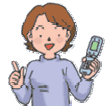 * This is an email service
* This is an email service* Service provided by NTT Docomo, au, Tuka
* Check with your provider for details
(Valid as of March 2005)
*40% "Cannot do a thing"
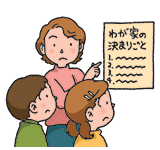 A survey of what went on during the
Hanshin-Awaji Great Earthquake in 1995 showed
that 39.5 % of people "could do nothing". People
tend to freeze with fear and panic when faced
with a natural disaster like
a powerful earthquake.
Being able to act calmly in
emergency situations
means that danger is
A survey of what went on during the
Hanshin-Awaji Great Earthquake in 1995 showed
that 39.5 % of people "could do nothing". People
tend to freeze with fear and panic when faced
with a natural disaster like
a powerful earthquake.
Being able to act calmly in
emergency situations
means that danger iscontrolled and lives are saved. It is well worth making a plan with your family about what you will do in an emergency.

Be prepared for life in an evacuation centre
 Life in an evacuation centre lacks freedom and privacy but having an attitude to understand and
help fellow evacuees makes the experience easier.
Life in an evacuation centre lacks freedom and privacy but having an attitude to understand and
help fellow evacuees makes the experience easier. * It is important to communicate effectively with others in the evacuation centre so that no one feels isolated (especially those injured, and those who are not normally part of the community e.g. travelers ).
* Talk with officials (e.g. centre staff, medical professional, police) at the evacuation centre to reduce your worries
* Try to not cause trouble for others
* Take measures to reduce stress. Simple exercise can be effective.
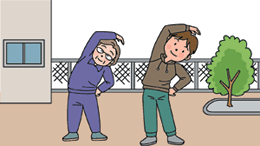 * Evacuation centres are not just run by government and volunteer groups, but local communities take part too.
* Evacuation centres are not just run by government and volunteer groups, but local communities take part too.* There is a danger of colds and influenza spreading, so take care to wash hands and gargle, and even wear a mask.
* If you stay in a vehicle be careful of blood clots like "economy class syndrome". Drink fluids and do limb exercises while in the vehicle. Do not stay in a vehicle for more than a few days.
Returning to a damaged house
A disaster official will attach a notice to each building according to its condition
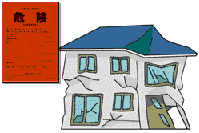 RED |
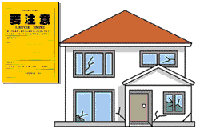 YELLOW |
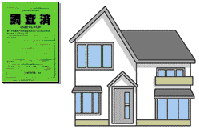 GREEN |
 * The gas supply to most buildings automatically shuts off during a level 5 quake. Be aware of how to perform a safety check and restore the gas flow at your home.
* The gas supply to most buildings automatically shuts off during a level 5 quake. Be aware of how to perform a safety check and restore the gas flow at your home. * Check the sewage system is restored by test-flushing the toilet before using it. Contact municipal authorities if there is a problem.
* Check for gas leaks before restoring the electricity breaker.
* If gas has escaped, ventilate in the building before using electricity. Do not use an electric fan to do this!
Master First Aid
It is possible that you are not able to receive an urgent care during times of disaster such as earthquake, which involves a number of injured people at the same time. Let's learn First Aid for an emergency.Hemostasis (Stop bleeding)
Although you may be in shock to see large amounts of blood, it is important to stay calm and stop the bleeding.Normally it is safe for adults to lose about 400ml of blood. Life becomes critical if an adult loses more than one third
of the body's blood (1500ml). First, observe how much bleeding there is and from where the bleeding comes.
* Blood is pouring out -- Arterial bleeding:Stop bleeding immediately
* Blood is welling out -- Venous bleeding:Stop bleeding as soon as possible
* Blood is oozing out
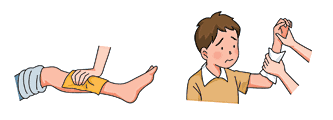 <Direct Pressure Hemostasis>
<Direct Pressure Hemostasis>* Cover the wound with clean gauze or cloth. Directly put pressure on the wound.
* Make sure the wound is elevated above the heart.
<Indirect Pressure Hemostasis>
When you have the condition of blood pouring out but are not quite ready for the direct pressure hemostasis, use this method temporarily by pushing the artery closest to the heart from the bleeding area towards the bone.
*Center of inner upper arm
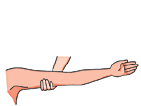 |
*Center of underarm
 |
*Wrist
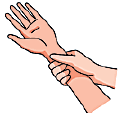 |
*Both sides of finger
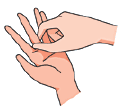 |
*Crotch
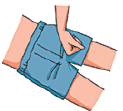 |
Broken Bone
 * Support the broken area with a brace and take the patient to the
medical care facility.
* Support the broken area with a brace and take the patient to the
medical care facility.* If you cannot find a brace, use alternatives such as board, magazine, umbrella and cardboard.
Burn
* Cool down the burned area under running water.* If too much water pressure exists, pour cold water into a small bucket and cool down the burned area in there.
* If the burned area is covered by fabric, run cold water over the fabric.
* If a wide area is burned, use the hose or bucket to pour cold water, or wet a large clean fabric such as a sheet to cover the entire area.
* If a child has widespread burns, put him or her in the bath tub with cold water (during warmer months).

You may face other cases where someone needs mouth-to-mouth breathing or heart massage. Learn how to give CPR through
classes given by the municipal office, fire department and Japan Red Cross. Major scuba diving groups may give classes as well.
Earthquake Help Sheet( keep for your records)
#Keep this with your earthquake emergency pack#Anyone can get help at any evacuation site
#See Mimitaro 60 for how to use Disaster Emergency Dengon Dial 171 to contact family
Kinkyujiyo Kojin Kiroku/ Emergency Use Personal Data
TEL:
TEL:
TEL:
Emergency Vocabulary (from you to a Japanese)
| ⇔ | Help! | |
| ⇔ | I don’t understand Japanese | |
| ○○ |
⇔ | I speak ○○ |
| ○○ ( |
⇔ | There is ○○ (an ill ・an injured person here・some one in the house) |
| ⇔ | (I’m) injured | |
| ⇔ | (I’m) ill | |
| ○○が ( |
⇔ | ○○ hurts (is painful) ( head・neck ・chest・back・stomach ・hand・arm・foot・leg) |
| ○○ ( |
⇔ | I have ○○ (diabetes・heart disease・ epilepsy) |
| ○○ ( |
⇔ | I am unable to use my ○○ ( ear・ eye ・ hand or arm ・ foot or leg) |
| ⇔ | I want to contact my family | |
| ○○ ( |
⇔ | Where is ○○ ? (evacuation place・doctor・)food・water・ supplies distribution・telephone・toilet ・bath・mobile phone charger) |
| ○○ ( |
⇔ | Is it possible to use ○○? (toilet・water・telephone・gas・bus・train ) |
| ○○ ( |
⇔ | (I) want ○○ (milkpowder・hot water・baby food・nappiesor diapers・blanket・sanitary towels・clothes) |
| ○○ ( |
⇔ | (I) cannot eat ○○ (health reasons・ religious reasons)(pork・beef・soba (buckwheat)・ eggs・fish) |
Emergency Vocabulary (from a Japanese to you)
| |
⇔ | Escape from here |
| ⇔ | Come with me | |
| ⇔ | (Its) dangerous | |
| |
⇔ | (Its)okay |
| ○○ ( |
⇔ | Please evacuate to○○ (evacuation site・primary or elementary school・/middle or junior high school・community centre) |
| ○○ ( |
⇔ | Please do not enter ○○ (house・ building・with out permission) |
| ○○ ( |
⇔ | ○○ will be distributed at <time> (food ・water・ supplies) |
Useful words~Get to know them now!
| |
hinanshiji – evacuation order | |
riyojikan – usage time |
|
||||||||
| hinan kaijo – (evacuation) all clear | |
kaki genkin – no naked flames | ||||||||||
| kaji – fire | |
kin en – no smoking | ||||||||||
| |
Dosha kuzure – landslide | |
kitsuen basho – smoking area | |||||||||
| kiken – danger | |
muryo/yuryo – free / charge | ||||||||||
| tachi iri kinshi – no entry | |
kashidashi – for rent / lend | ||||||||||
| |
yoshin – after shock | |
tsuko kano – passable | |||||||||
| |
okyushochi – first aid | |
tsuko kinshi – no through road | |||||||||
| |
kyugosho – first aid | |
shoto jikan – blackout period | |||||||||
| pesumeka - pacemaker | |
economy class shokogun – economy class syndrome | ||||||||||
| jinko toseki – artificial dialysis | fukkyu – restoration | |||||||||||
| |
taki dashi – emergency food (rice) | り |
risaishomeisho–certificate of earthquakedamage | |||||||||
| |
kyusuisha – water truck |
→Evacuation Centre Map(PDF)








